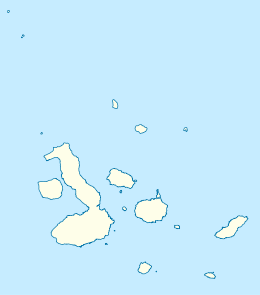Santiago Island (Galápagos)
Santiago Island (Spanish pronunciation: [sanˈtjaɣo]) is an island of the Galápagos Islands.[1][2] It is also known as San Salvador, named after San Salvador Island, or as James Island. The island, which consists of two overlapping volcanoes, has an area of 585 square kilometers (226 sq mi) and a maximum altitude of 907 meters (2,976 ft), atop the northwestern shield volcano. Marine iguanas, sea lions, fur seals, land and sea turtles, flamingos, crabs, dolphins, and sharks are found here. There are many goats and pigs which were introduced by humans to the islands and have caused great harm to the endemic species. Darwin Finches and Galápagos Hawks are usually seen as well as a colony of Fur Seals. At Sullivan Bay, a recent (1897) pahoehoe lava flow can be observed.
 Santiago Island | |
| Geography | |
|---|---|
| Location | Galápagos Islands, Ecuador |
| Coordinates | 0.252364°S 90.717952°W |
| Archipelago | Galápagos Islands |
| Administration | |

_topographic_map-en.png)
Puerto Egas, south of James Bay and west side of Santiago, is one of the best sites. There is a long, lava shoreline where eroded rock formations house an excellent variety of wildlife. Marine iguanas bask in the sun. The tide pools contain many Sally Lightfoot crabs, which attract other types of hunters. Following the trail Fur seal lions are found. Puerto Egas is not only a good spot for taking pictures but also perfect for snorkeling and seeing many species of tropical fish.
Sullivan Bay is especially fascinating for those who are interested in geology and volcanology. You can walk over the uneroded, black lava flow covered with lava bubbles and tree-trunk molds in the surface. There are two small beaches where turtles come for nesting.
Cousin's Rock is a well-known dive site and is situated off the east coast of Santiago. It is a triangular rock that rises about 10 m (33 ft) out of the water and is made up of many layers of volcanic rock.
Sombrero Chino (Chinaman's Hat) is a small islet off the southeastern tip of Santiago. A 52-meter-high (171 ft), 0.22 km2 (0.085 sq mi) volcanic cone, it is named for its resemblance to the conical Asian hat.[3]
Restoration
The Directorate of Galápagos National Park and Island Conservation reintroduced 1,436 Galápagos Land Iguanas (Conolophus subcristatus) to Santiago Island on the 4th January 2019 after a 180 year absence. The partners reintroduced the land iguanas in an effort to restore the island’s ecological health and to provide the opportunity for this iguana species to thrive. Land iguanas were sourced from North Seymour Island, where they were introduced in the 1930s and have increased to over 5,000 and faced a lack of food availability. Charles Darwin was the second-last person to record land iguanas alive on Santiago Island in 1835, with Abel-Nicolas Bergasse Dupetit Thouars being the last in 1838.[4][5][6][7][8][9]
References
- "SANTIAGO ISLAND (SAN SALVADOR, JAMES), GALAPAGOS". animalcorner.co.uk. Retrieved 6 June 2017.
- "Santiago". Galapagos Conservancy. galapagos.org. Retrieved 6 June 2017.
- Kricher, John (February 13, 2006). Galápagos: A Natural History. Princeton University Press. p. 210. ISBN 978-0691126333.
- "Threatened Galápagos Land Iguanas Return to Santiago Island En-Masse After 180-Year Absence". Island Conservation. Retrieved 9 January 2019.
- "Galápagos island gets its first iguanas since Darwin after mass-release". The Guardian. Retrieved 9 January 2019.
- "Iguanas reintroduced to Galapagos island after 200 years". CNN.com. Retrieved 9 January 2019.
- "Iguanas Are Being Reintroduced to a Galapagos Island Two Centuries After They Disappeared". TIME. Retrieved 9 January 2019.
- "Iguanas reintroduced to Galapagos island after almost 200 years". The Independent. Retrieved 9 January 2019.
- "Iguanas Reintroduced to the Largest Galapagos Island After Nearly 200 Year Absence". Earther. Retrieved 9 January 2019.
External links
![]()